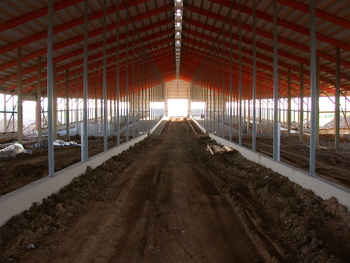Grant funds free nationwide access to Dairyland Initiative for farmers

Tie stalls with sand bedding reduce lameness in cows and increase comfort, which leads to greater milk production. The Dairyland Initiative helps dairy producers incorporate these stalls in new or modified barns.
Photos: The Dairyland Initiative
The Dairyland Initiative, a UW School of Veterinary Medicine outreach program that works with farmers to optimize cow comfort, health, and milk production, has received a $50,000 grant from the Dean Foods Foundation to make its Web-based resources available at no cost to dairy farmers across the country.
“The Dairyland Initiative operates under the well-established premise that dairy cows produce at the highest levels when they’re immersed in an environment that accommodates their comfort needs,” says Nigel Cook, professor of food animal production medicine.
“We intended to create a resource where, in one location, dairy producers can find all the information they need to build welfare-friendly facilities for their cattle. Three years later, we can make this resource available to all U.S. dairy farms, free of charge,” Cook says.

The new barn includes ergonomic stalls that allow cows to move more naturally and larger alleys that help cows easily access feed, water, and resting space.
The Dairyland Initiative delivers building plan assessments and other valuable information based on the latest dairy animal research and years of collective field experience in dairy housing. For example, its experts work closely with farmers to plan new construction and remodels of dairy barns, which includes:
- updating old tie stall or stanchion barns with mattresses and sawdust bedding to safer tie stall designs and sand bedding;
- modifying freestalls for improved comfort; and
- planning entire dairy housing facilities for calves through adult cows.
Changes like these help reduce injury, disease, and lameness, often leading to an increase in milk production.
“As a dairy company, responsible agriculture is a key focus area, and we are committed to promoting improved animal welfare among dairy farmers,” says Liliana Esposito, Dean Foods Foundation president. “We are pleased that farmers nationwide can now take advantage of this program that offers up-to-date information and best practices on farm resource management provided by experts in this field.”
Dairy farmers can take advantage of The Dairyland Initiative’s services through consultations, workshops and Web-based tools. Previously, Wisconsin farmers could access the website for free while those outside of the state paid a nominal fee. The grant will help make the website available at no cost to farmers and university extension programs nationwide for two years.
“The concepts behind the ‘Wisconsin Blueprint’ recommendations of our website address the physical and social needs of calves, heifers and cows no matter the location.”
Ken Nordlund
“The grant will remove a significant barrier to use of the program outside of Wisconsin,” says Ken Nordlund, clinical professor of food animal production medicine. “While different climates will dictate some differences in how dairy cattle are housed, the concepts behind the ‘Wisconsin Blueprint’ recommendations of our website address the physical and social needs of calves, heifers and cows no matter the location.”
Cook and Nordlund launched The Dairyland Initiative in October 2010 with a seed grant from UW–Madison’s Ira and Ineva Reilly Baldwin Wisconsin Idea Endowment. Since then, the program has assisted more than 200 dairy farms and trained more than 200 professionals in important aspects of facility design, including calf barn ventilation and transition cow barn planning. At least 1,600 farmers, builders, veterinarians, and other consultants have referenced the website, registering more than 14,500 daily log-ins to access the most up-to-date resource on welfare-friendly dairy cattle housing.
The Dairyland Initiative receives financial and networking support from the Professional Dairy Producers of Wisconsin and their foundation as well as donations from several other sponsors.
